Once upon a time, 350cc was one of the most popular categories in motorcycling. From traditional British singles, through to sporty twins and even a motorcycle Grand Prix category, 350s were second only to 500s when it came to the performance hierarchy.
But as engines became bigger and more powerful, so 350s became relegated to commuters on their way to obscurity. In a modern world, where motorcycles are more likely to be categorised by power outputs, power-to-weight ratios and licence requirements, so the actual capacity of the engine has been less and less relevant. That hasn’t stopped Royal Enfield though, and they are back with a classically styled machine featuring a traditional 350cc single cylinder engine, producing a fairly modest 20bhp.
It’s called the HNTR 350 in the UK, which I assume you are meant to pronounce as ‘Hunter’. As a middle-aged man with a fondness for vowels, I think it’s a silly name but I think there’s some trademark related reason behind it because it is actually called Hunter in other markets, so I’ll let them off on this occasion. It’s clearly aimed at younger riders, with Royal Enfield’s promotional pictures (some of which we’ve used to illustrate this article) showing trendy young riders frolicking around London on their pack of HNTRs.
While I am sure the average age of the British buyer will be a good bit higher than the promo models, it does actually make a fantastic motorcycle for younger riders to gain their spurs on. It’s very manageable and unintimidating, not to mention really stylish - qualities which actually make it very endearing to riders at the other end of their riding careers as well. The names given to the six available colour schemes also declare the marketing department’s unashamed desire to appeal to a hipster audience. The more subtle ‘Dapper’ liveries come in a choice of white, grey or fern green hues, while our test bike came in Rebel Blue, with the Rebel graphics also available in two-tone red and black or white and black combos.
Royal Enfield have been doing insanely well in recent years and a big part of that success comes down to delivering good quality products at very reasonable prices. The HNTR 350 starts at £3899 for the ‘Dapper’ coloured bikes, with our ‘Rebel’ liveried example costing an additional £80.
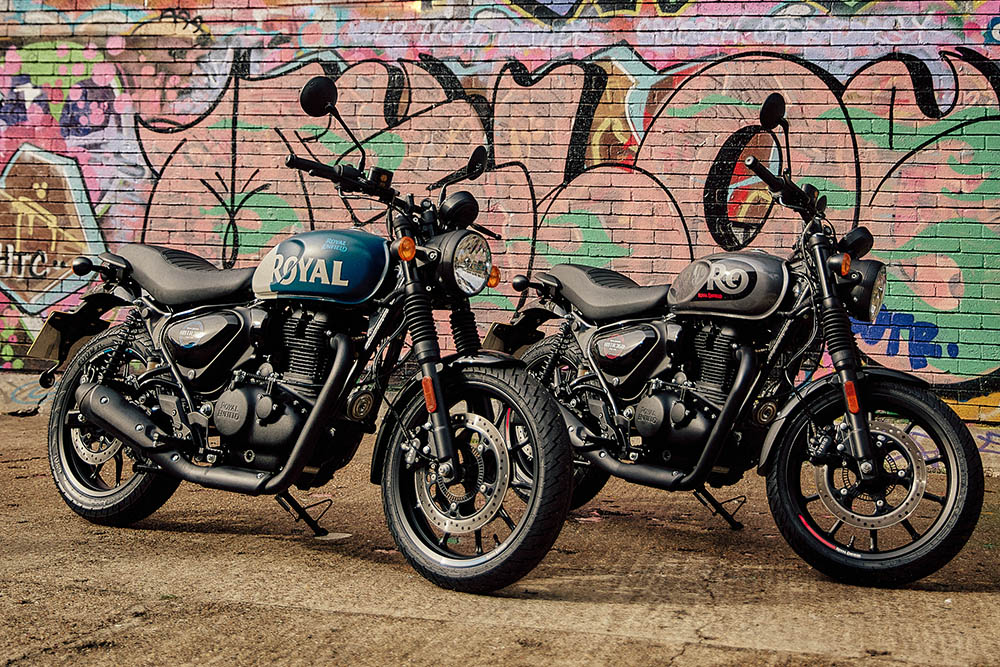
First impressions count
I’ve said it before about Royal Enfields, and I will say it again. One of the best things about modern Enfields is that although they are relatively inexpensive to buy, they feel substantial when you sit on them. From a distance the HNTR 350 looks well proportioned and, although it is physically quite small (the seat height is 790mm), climb aboard and you’re greeted with a machine featuring components which feel like they belong on a bigger, more expensive, bike. The touchpoints of the machine are all comfortable; the levers are chunky, the grips plush and the switchgear well made. Speaking of the switchgear, I love the design of the big red starter/kill switch button, which resembles a retro on/off switch. Sometimes little design and engineering touches are sacrificed by accountants in the name of saving money, but I honestly didn’t feel that this was a bike thrown together as cheaply as possible. Corny as it sounds, I really like the way in which Royal Enfields feel like they’ve been put together with care and respect for the brand. Sure, it’s not a BMW or Ducati in terms of detail touches and outright build quality, but then it isn’t a BMW or a Ducati in terms of the sticker price either.
Thumb the starter and the air cooled motor diligently whispers in your ear. It’s smooth and quiet, like pretty much any other Euro5 engine, but there’s at least there’s something there. It might be muted, but that classic single rumble is in there somewhere.
With just 20bhp on tap, it’s hardly the quickest machine out there, but if you are graduating from a 125 you will definitely feel the benefits of the additional engine capacity as soon as you pull away. The controls are light and the five-speed gearbox shifts effortlessly. My first impression was of how incredibly smooth and civilised it is. Think of a ‘big’ single and you inevitably wince at the thought of teeth chattering vibrations. Not so with this, it is creamy smooth even when being revved out. I had to double check it wasn’t a parallel twin I was aboard.
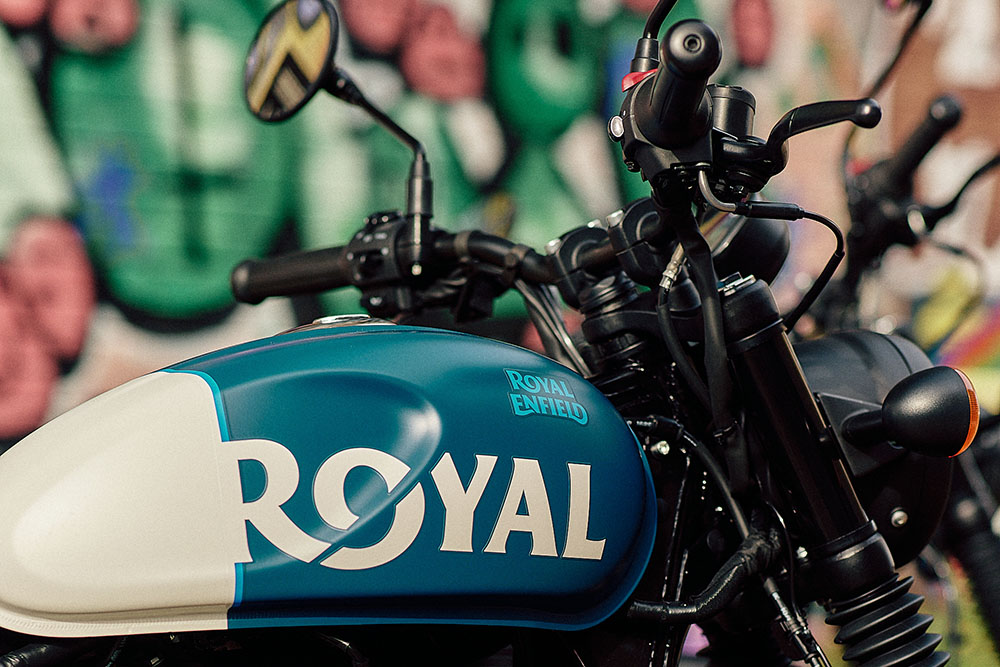
Around town it’s an absolute pleasure to ride. At 181kg it’s a bit heavier than the average 125, but you really don’t notice it. Behind the handlebars is a nice place to be. The saddle also has a premium feel to it and is pretty heavily tapered to help littler legs get their feet down at the lights. The minimalist dashboard gets the balance between aesthetics and giving a good amount of information to the rider pretty much spot on. There’s no rev counter but, to be honest, you don’t need it on this low revving single. What you do get is a fuel gauge, clock and gear indicator, while the analogue speedo is really easy to read. Also handy is the addition of a USB-C charging port, which is neatly tucked at the back of the left hand switchgear and ideally located for handlebar mounted smartphones.
The 350cc J-engine is a relatively recent design. Even if the technology is all pretty basic, it is well engineered and a far cry from the old 411 engine used in the old Himalayan. It debuted in the cruiser styled Meteor, which we reviewed a few years ago, and is also found in the latest version of the iconic Bullet and the 1950s styled Classic. The HNTR has a more contemporary modern classic look to it and, personally, I think it’s got a fair bit of Triumph’s Speed Twin 900 in its lines, which is no bad thing. It’s a proper poser’s bike. I reckon it’ll be well enough received by experienced bikers if you rock up at a bike meet, while non-bikers don’t need to know it’s a mere 350. If it wasn’t for the numbers on the side panels, you could easily pass it off for a 500 or even bigger.
Around town it is one of the easiest bikes you could ever ride. Its compact dimensions might put some off but, that aside, it’s a very accessible machine which carries its weight well. The controls are all light and precise, the turning circle is tight and the brakes are decent, needing a solid tug on the lever but bringing the bike to a halt with no dramas.
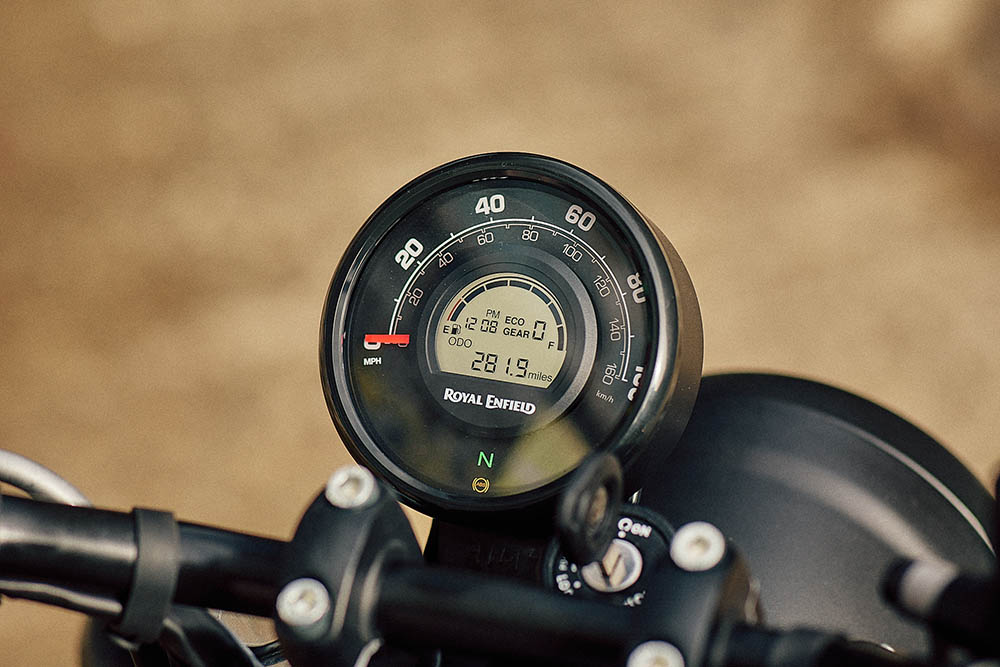
Take it out on the open roads and it starts to get a bit exposed. In terms of speed, 70mph is pretty much top whack. It’s only a little quicker than a 125 but the good thing is that it gets there quicker and is able to maintain v-max up slight inclines, where a learner bike would struggle and shed speed. As a sedate B-road cruiser it has its charms, but speed merchants are hardly going to be impressed. Royal Enfield’s Interceptor 650 is one of my favourite modern classics on sale today and, if you want more performance, is well worth looking at.
The spec, although basic, is better than I would have expected for a sub-£4k machine. The CEAT tyres are ok, as are the suspension and the brakes, which are from Brembo’s ‘ByBre’ subsidiary. You could find areas to nit pick with it all, but at the price I’d say they exceed my expectation. The rear suspension, incidentally, has six-way preload adjustability, which is useful if you are heavier or regularly take a passenger.
Typically for an Indian bike, it has some of the quaint stuff we used to have on all bikes back in the day, and which still aid practical motorcycling. The centre stand means you can adjust the chain with ease, fork gaiters keep dirt out of the seals, the extended front mudguard stops the worst of the debris being thrown up on to the engine and rider. The rear grab handles are big and are great for strapping on soft luggage when you don’t have a passenger. It’s a wonderfully practical machine and will surely be easy for the home mechanic to work on. Earnest commuters like this were commonplace in the 1970s and ‘80s and, although a rarity today, I can see how modern Enfields appeal to classic bike fans looking for a reliable set of wheels with all the traditional values.
We didn’t get the opportunity to truly test the fuel economy during our time with the HNTR, but we have no reason to doubt the manufacturer’s claimed 85mpg. The 13 litre tank should be good for over 200 miles between stops.
Other than the daft name, there’s not too much I don’t like. The mirrors are a bit too low and small for me, but they do work well and give a clear view – which isn’t always the case with singles, due to vibrations, but that’s about it. Sure, I’d prefer a little more power, a bit better brakes and some plusher suspension, but considering what it is and what it costs, I think the Royal Enfield HNTR 350 hits the mark pretty well.
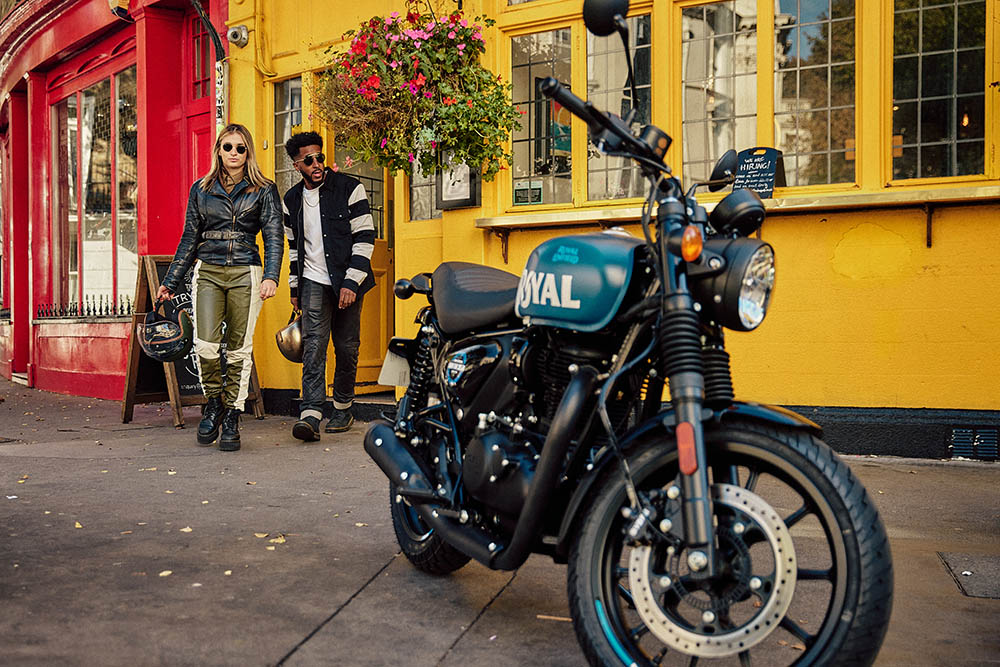
Final thoughts
There’s an authenticity to Royal Enfields which I really admire, and which continues with this model. It’s aimed at a slightly different demographic yet manages to remain true to the brand. It’s a very ‘clean’ design, which lends itself to additional customisation. Royal Enfield have produced a range of official accessories, which allow for some simple modifications to be made. Optional parts include flyscreen, luggage, bar end mirrors and alternative seat units. There are also engine crash bars, which should protect the bike from some damage in the event of a slow speed drop.
The Royal Enfield HNTR 350 sits in a slightly barren sector of today’s motorcycle market. It’s a good bit cheaper (albeit significantly less well specified) than more modern A2 retro designs like the Husqvarna 401 range and Triumph’s new Speed 400X, and is closer in price to lesser known brands, with the Herald Brat and Maverick 250s, and Mash’s TwoFifty and 500 also playing a similar game.
For younger riders, looking for a first or second motorcycle, the choice may well be between a 125 or the HNTR. At £3899, the Enfield is actually a few hundred quid less than Kawasaki’s learner legal Z125, for example. The bikes offer comparable performance but, once you take into account the costs and time associated with getting an A2 licence, for many the 125 is still going to work out less expensive and more accessible.
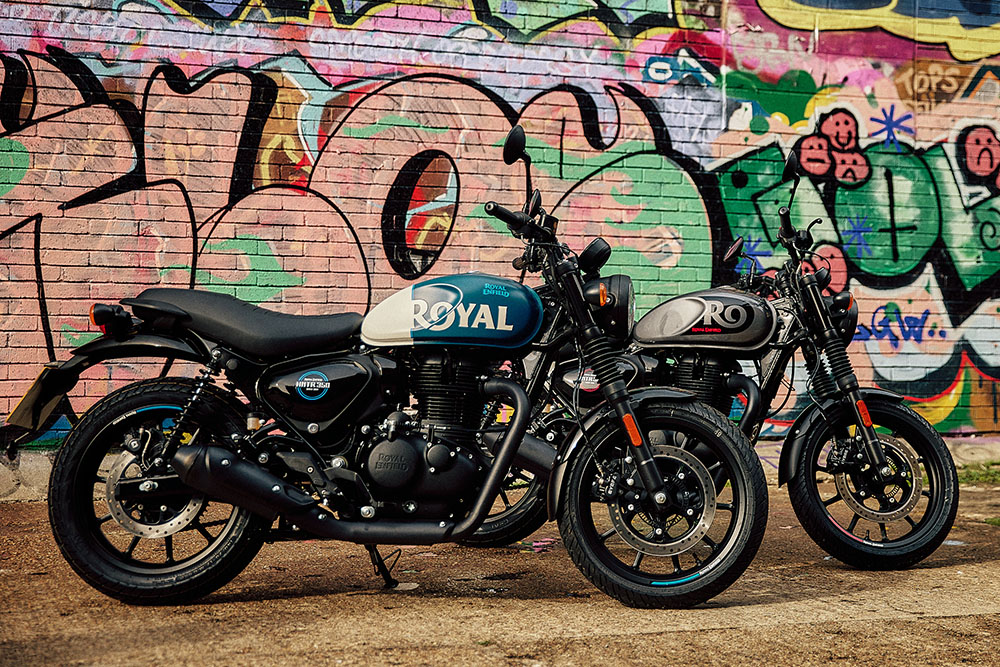
And that’s probably one of the biggest challenges faced by the HNTR 350, at least in Europe where the engine capacity and power output limits its appeal. Taken in isolation, it’s a fine little bike but, once you take licencing requirements into account, you feel it doesn’t quite offer enough performance to convince many inexperienced riders to trade in their 125s and go through an A2 licence test. It’s not an issue in India, where they are sold in much bigger numbers than here, but given that 125s are so much more accessible to new riders than a 350, I fear it will be a limiting factor in getting younger people on to the HNTR.
The irony is that the HNTR 350 is almost the perfect starter bike. The extra torque it possesses over a 125 actually makes it easier to ride than most A1 machines, while top speed is more or less the same. The HNTR 350 is inexpensive and seemingly sturdy enough to handle the inevitable rookie drops. Given the choice, I’d rather have my kid ride one of these when they are 17, but rules is rules I guess.
But, in spite of this and just like the Meteor 350, they have already sold well in the UK, being one of the top 10 best selling motorcycles of 2023. It’s understandable too. The Royal Enfield HNTR 350 is well built, looks great and is one of the least expensive motorcycles you can buy today. If you’re in the market for a mellow modern classic and most of your riding is in the city, or you’re not too bothered about the lack of top speed, the Royal Enfield HNTR 350 is certainly worthy of consideration.
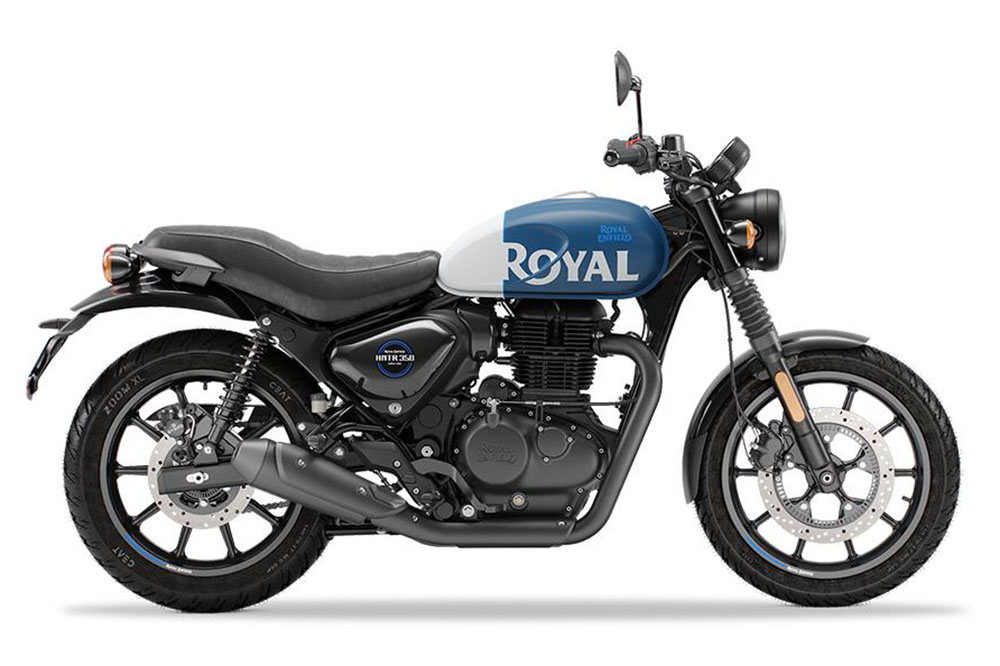
Royal Enfield HNTR 350 specification
Price: From £3,899
Engine: 349cc, air-cooled, two-valve, single cylinder
Power: 20.2bhp @ 6,100rpm
Torque: 27Nm @ 4,000rpm
Suspension: 41mm telescopic front fork. Twin rear shock absorbers with six-way preload adjustment
Wheels: Cast alloy, 17” front and rear
Tyres: Tubeless, front 110/70-17, rear 140/70-17
Weight: 181kg (wet)
Seat height: 790mm
Fuel tank: 13 litres
Contact: www.royalenfield.com



